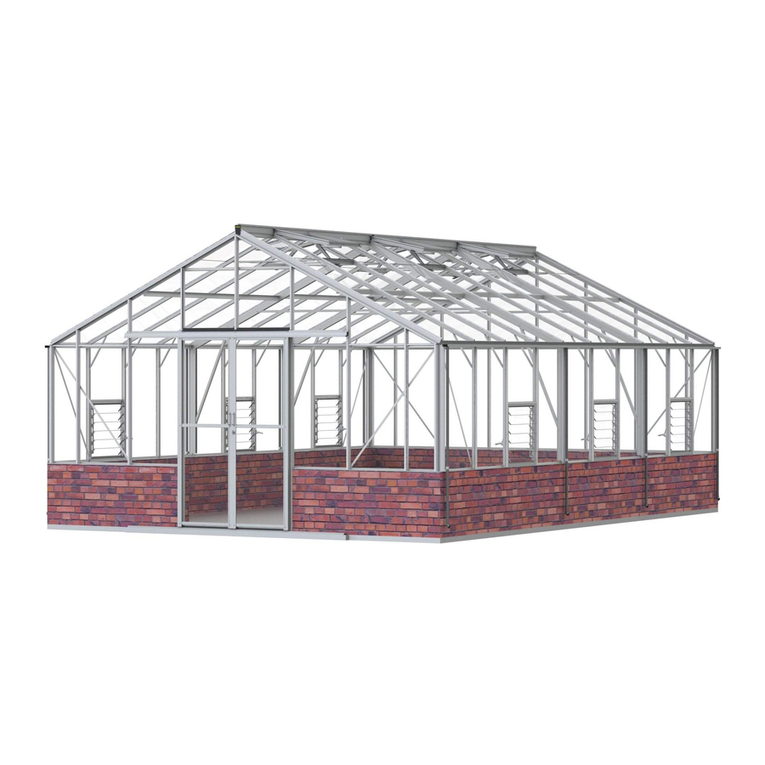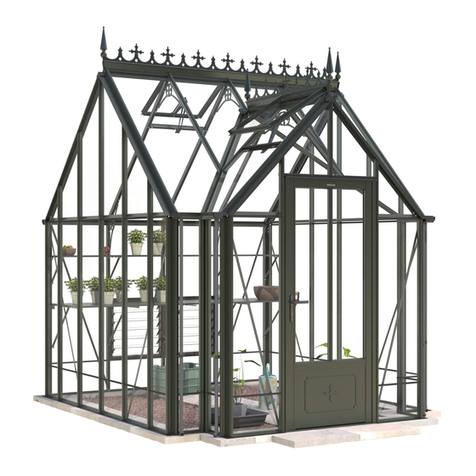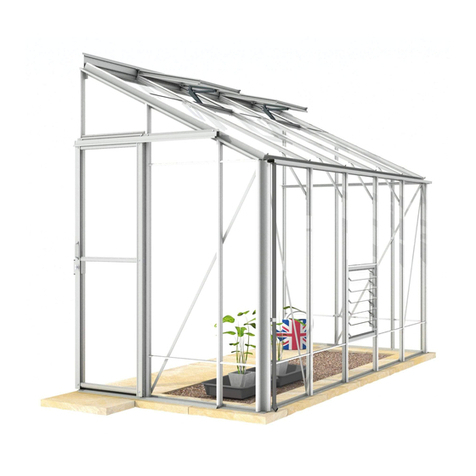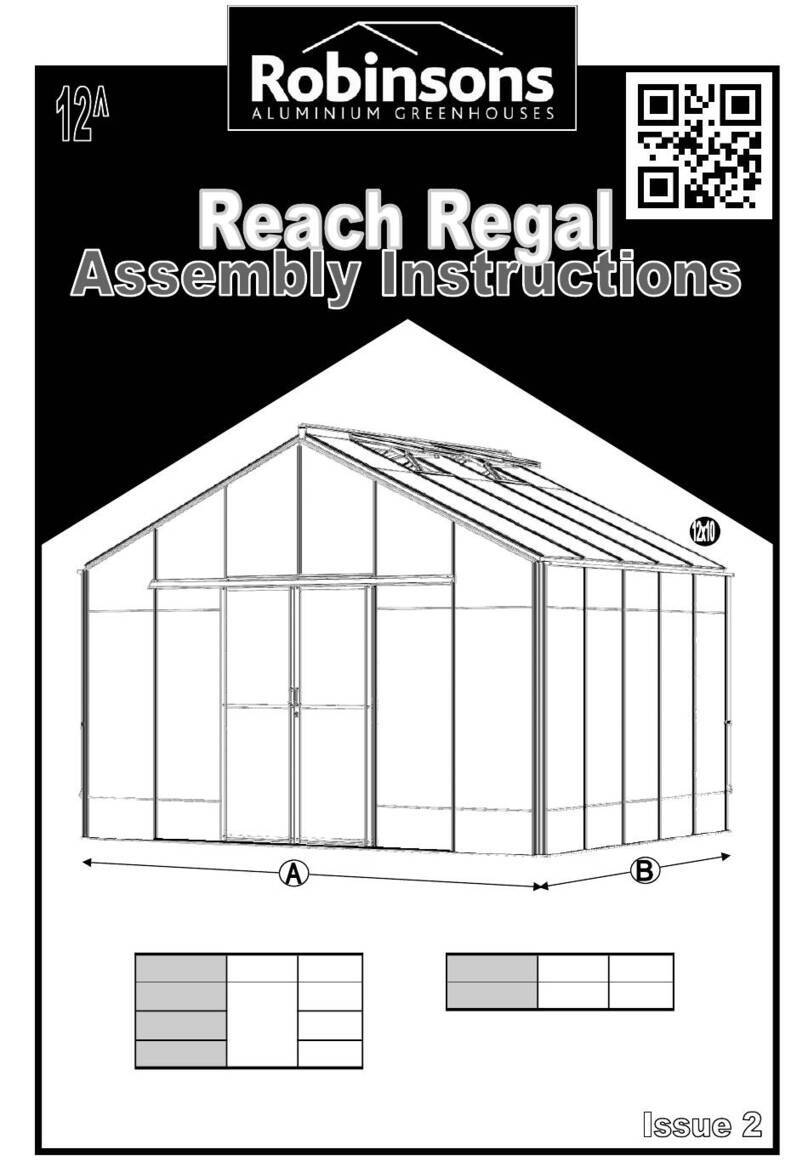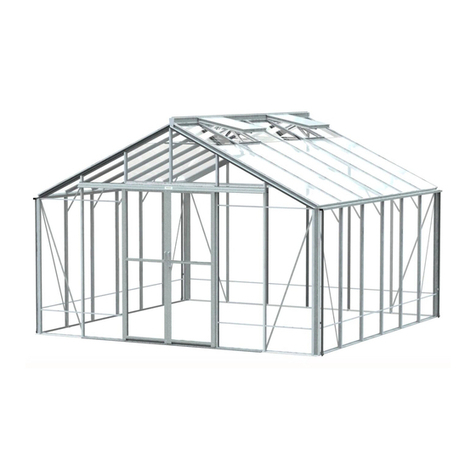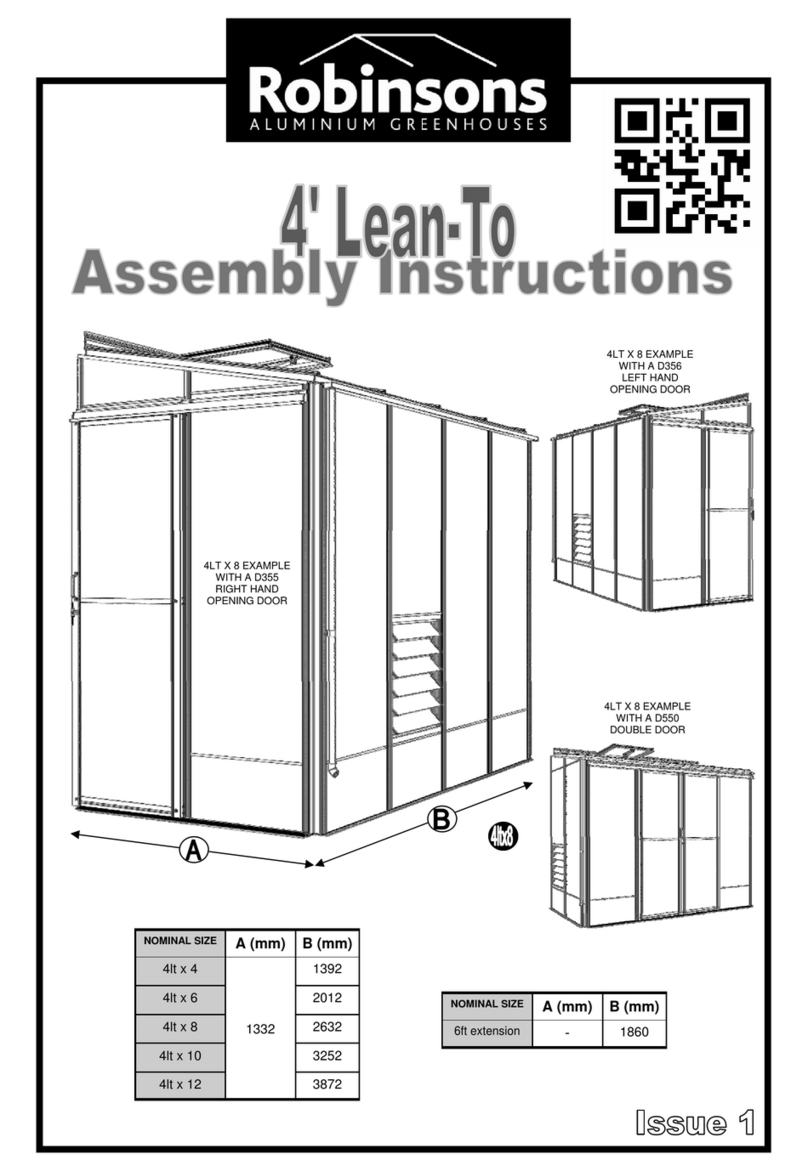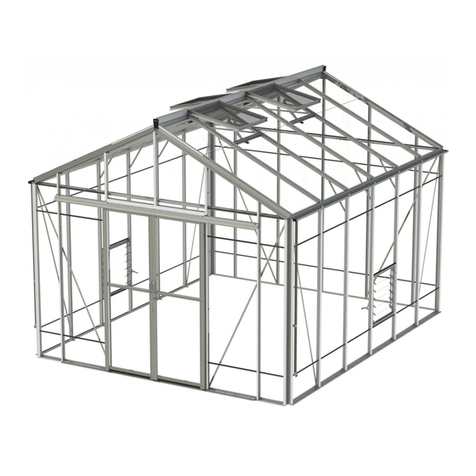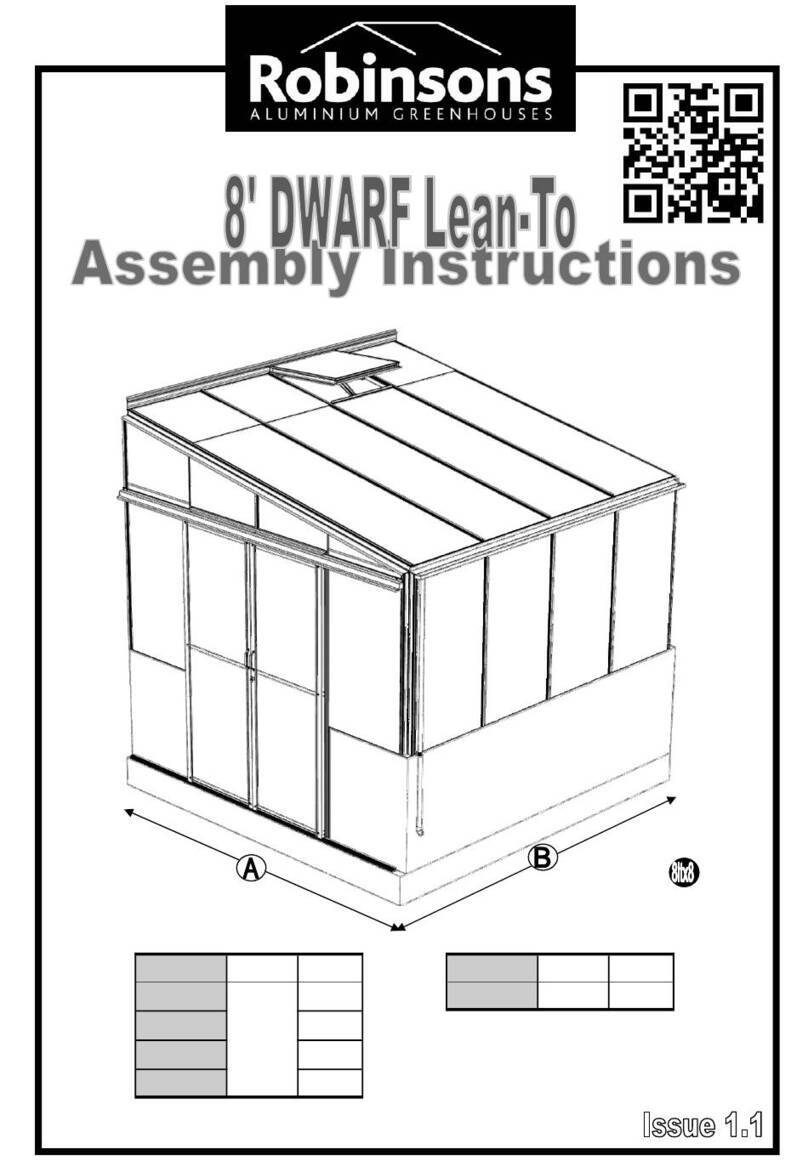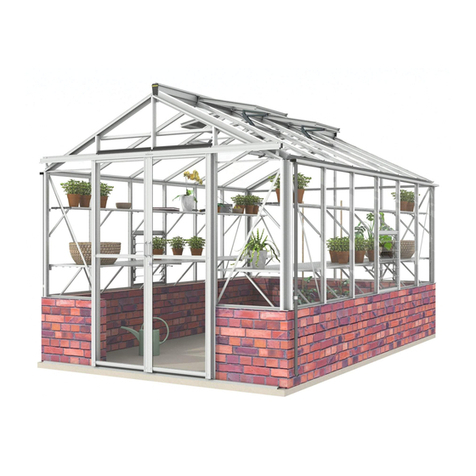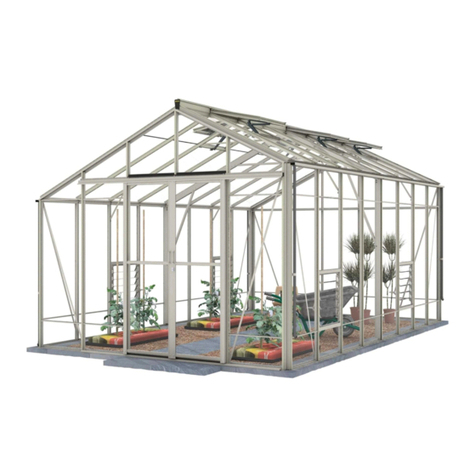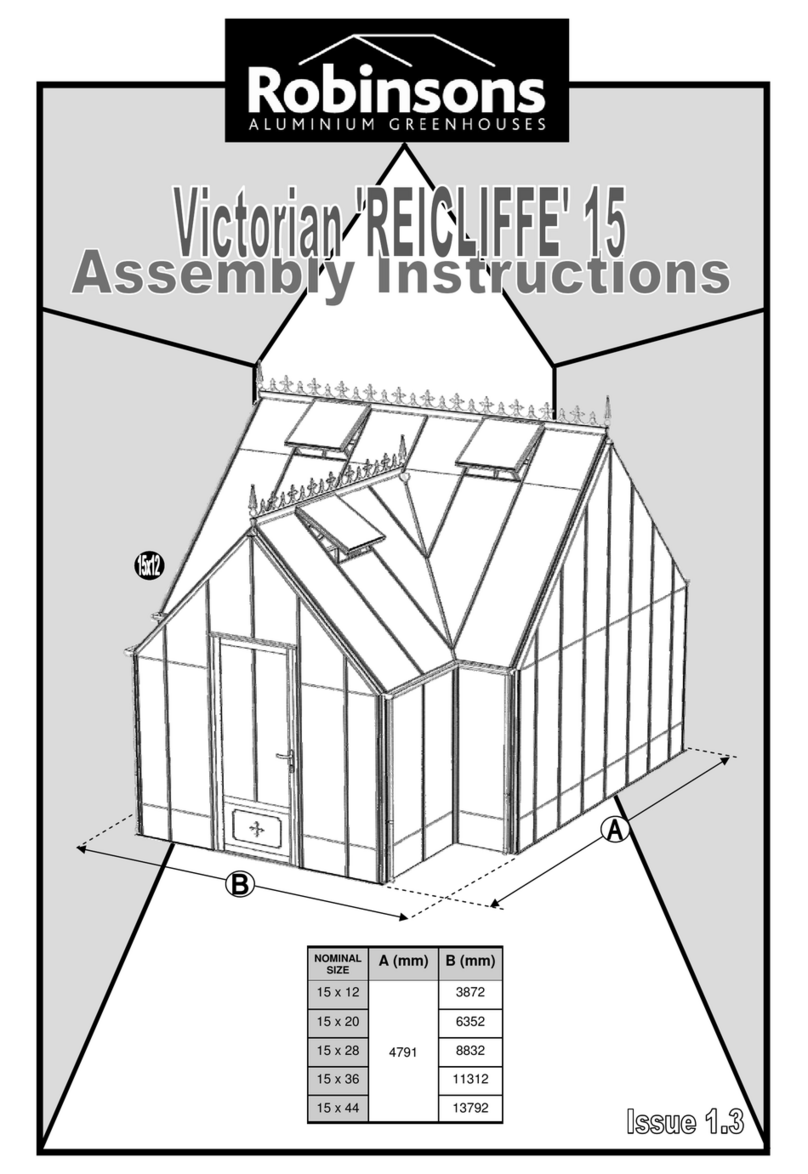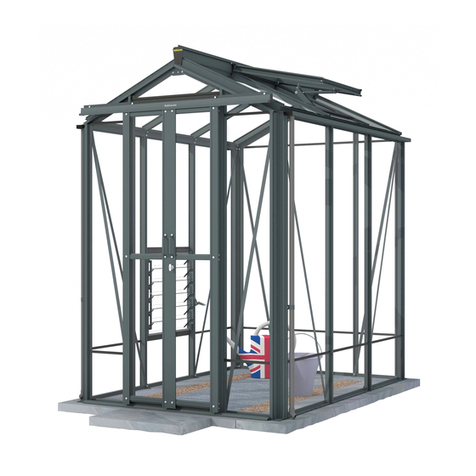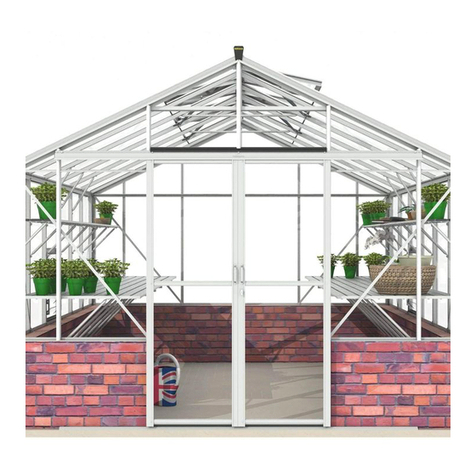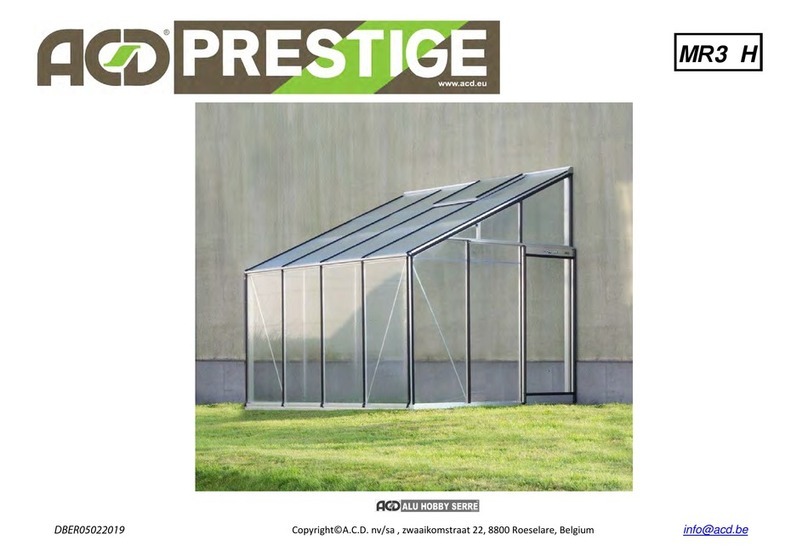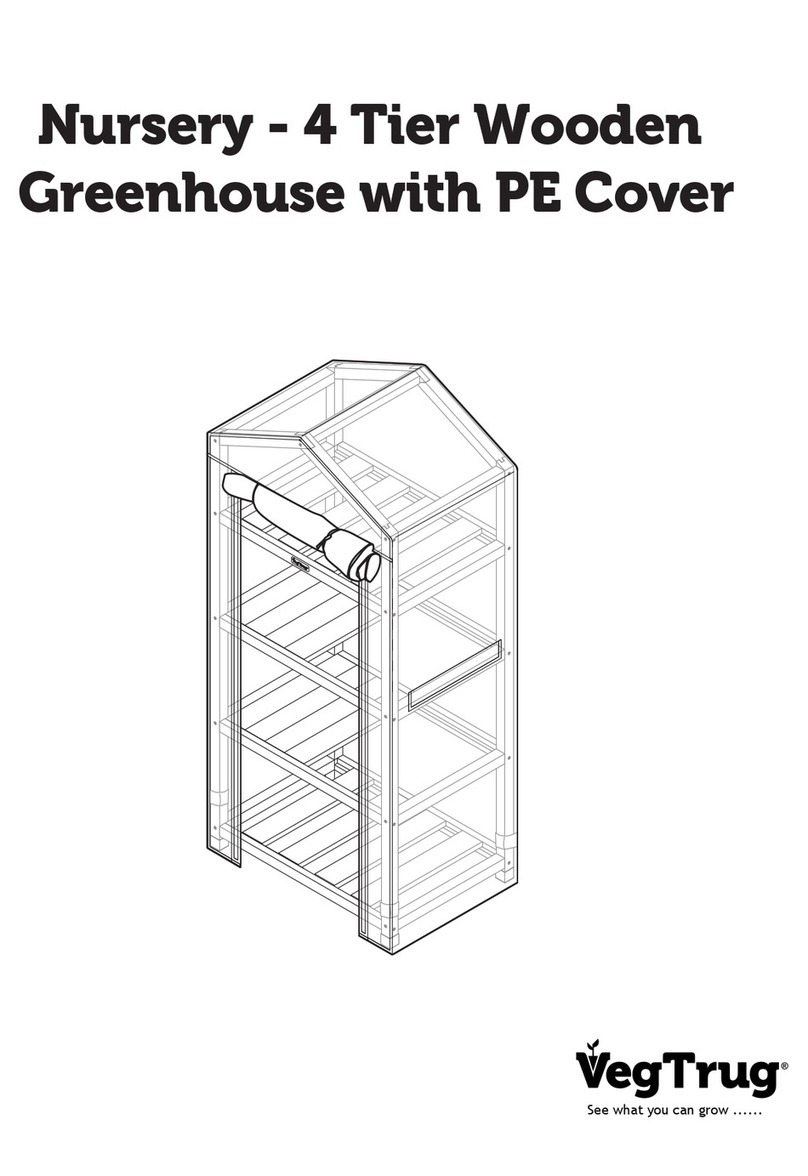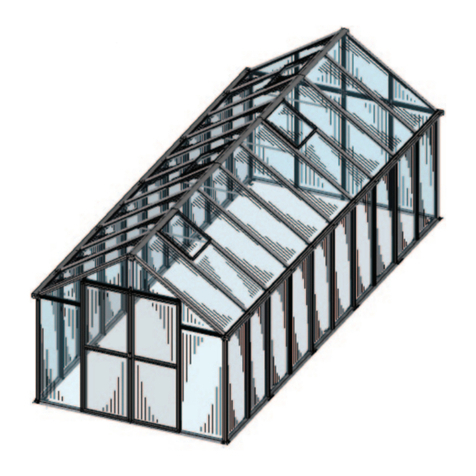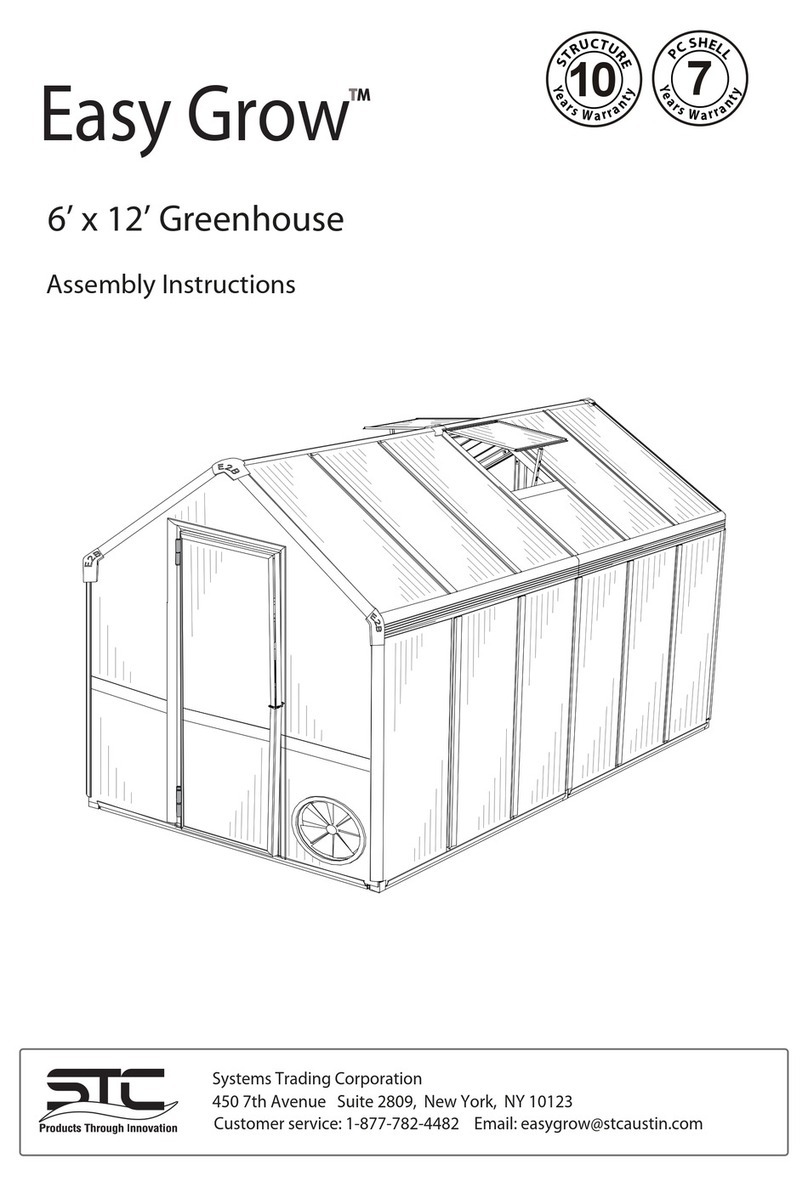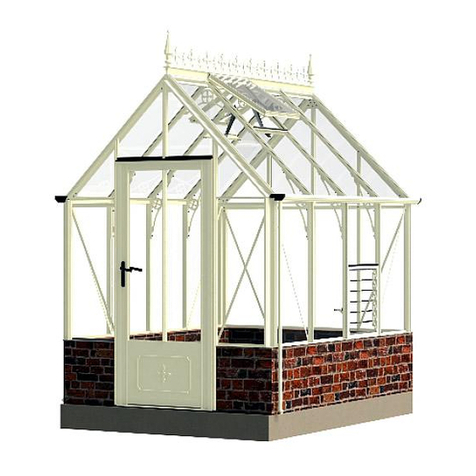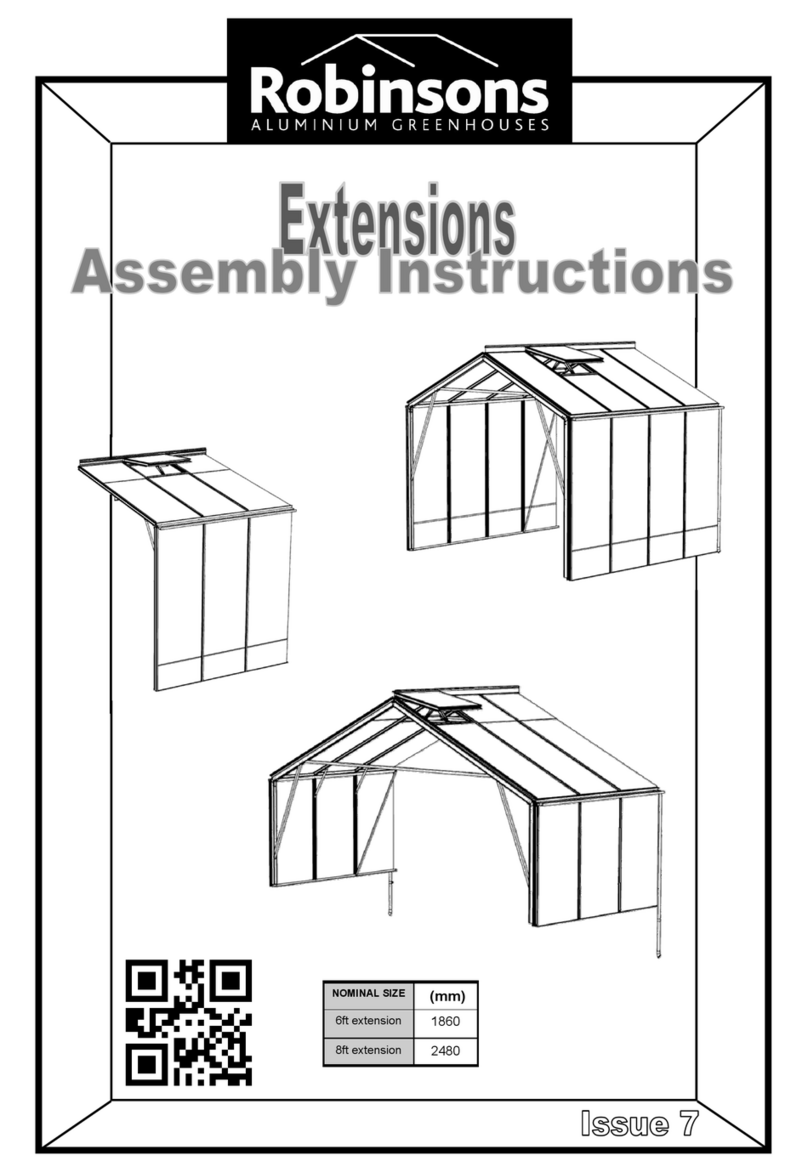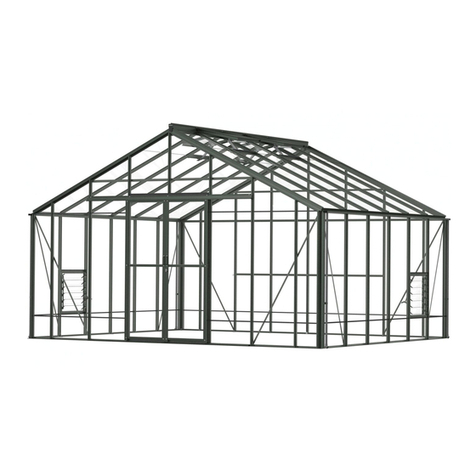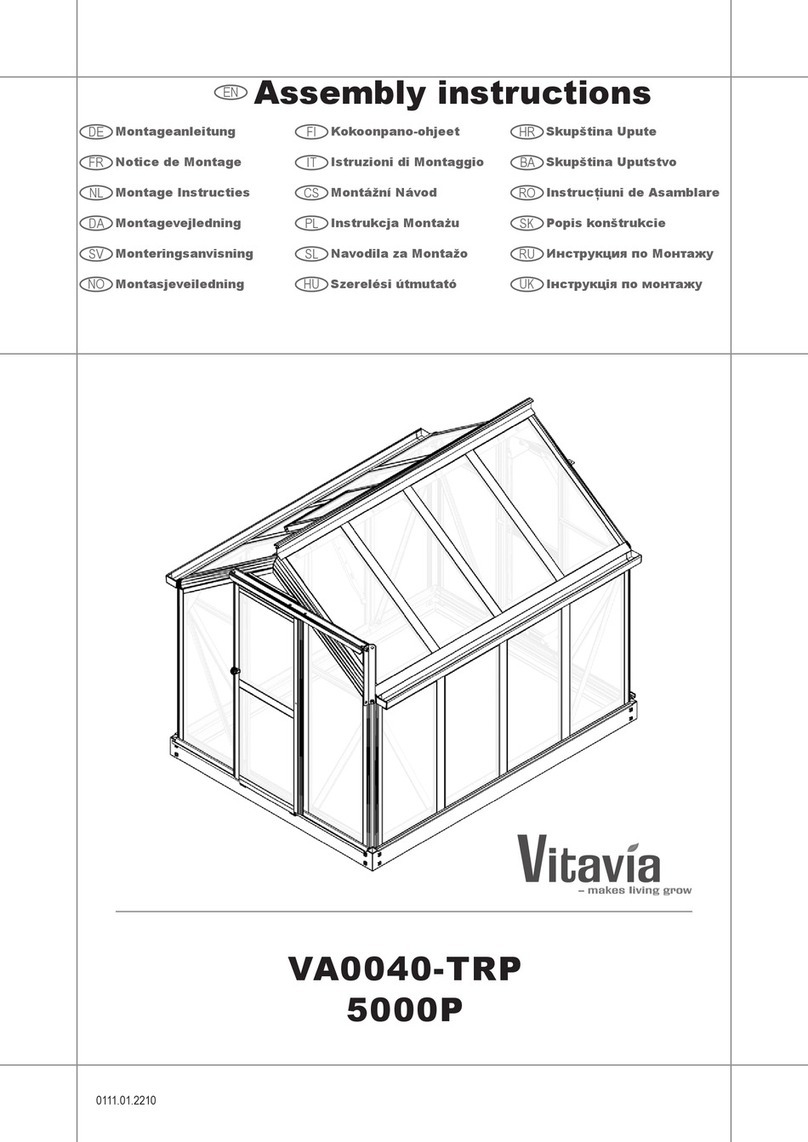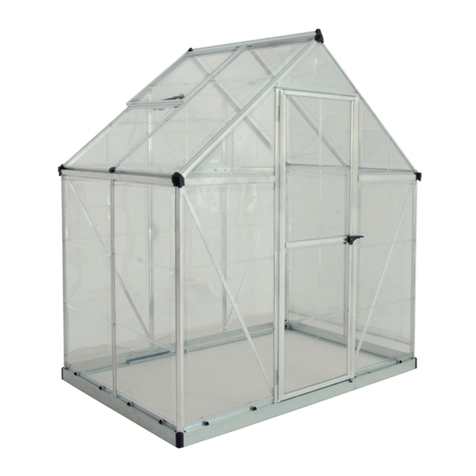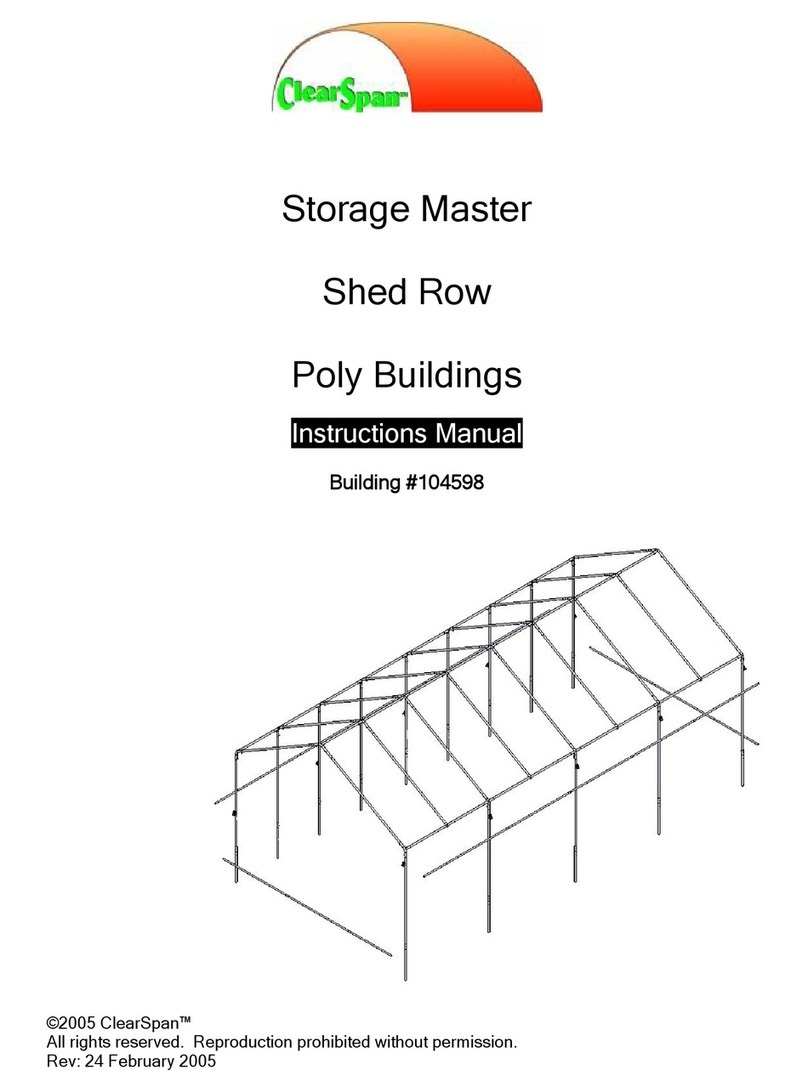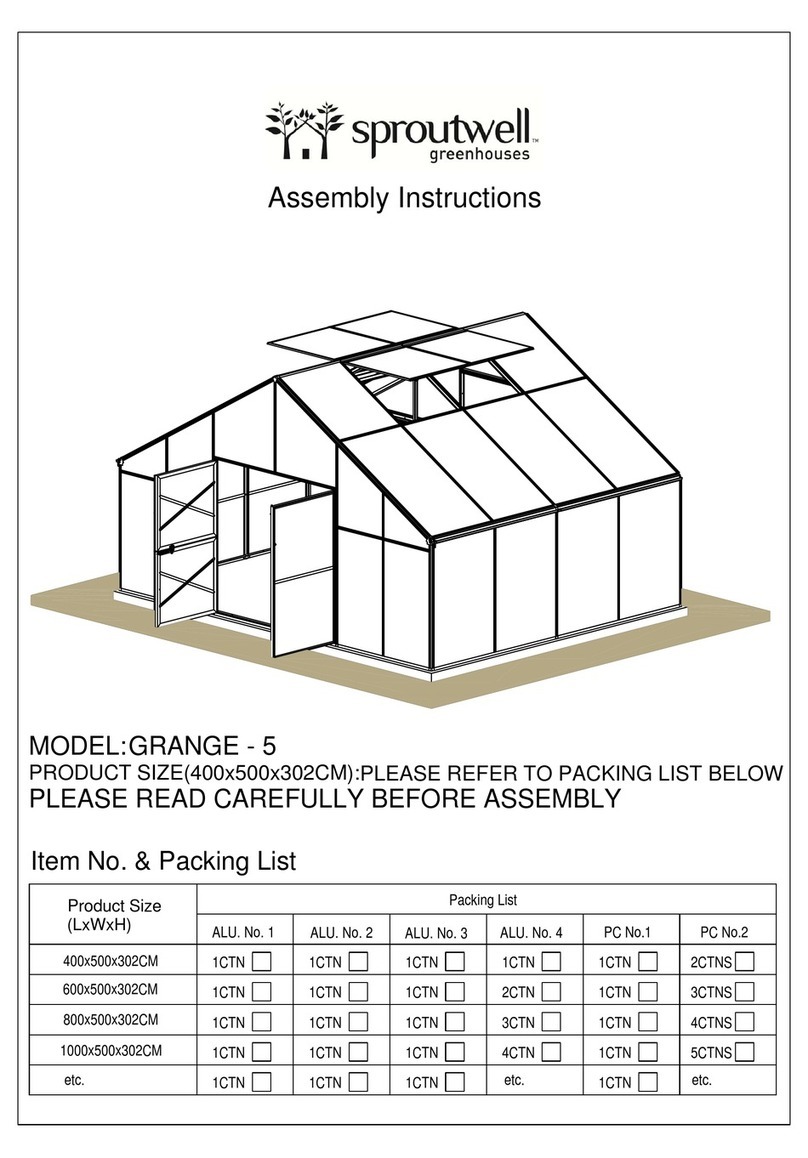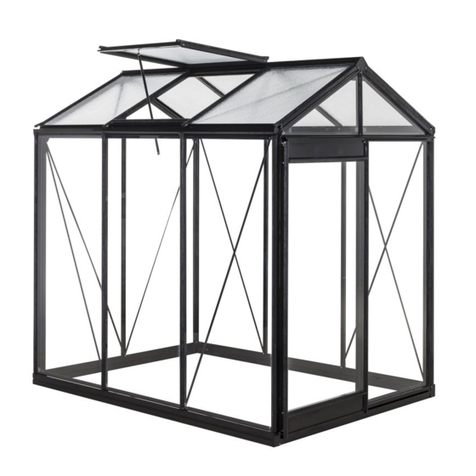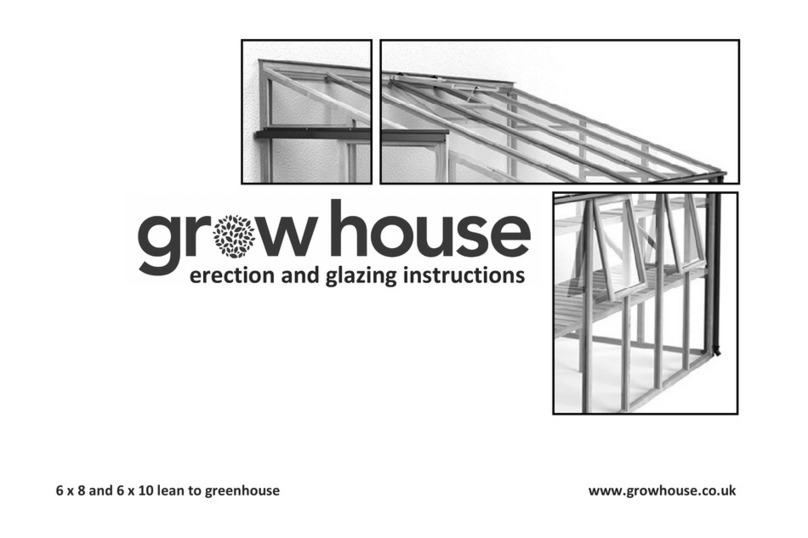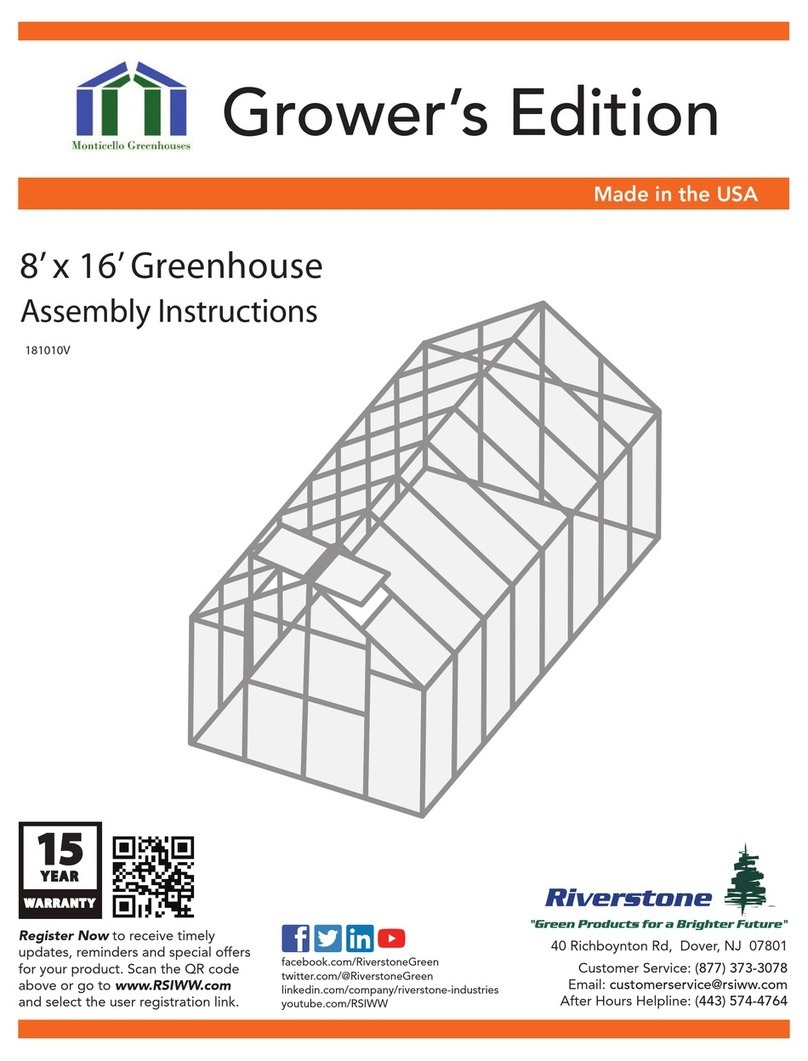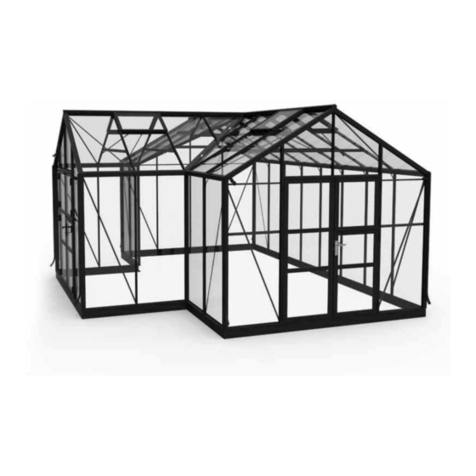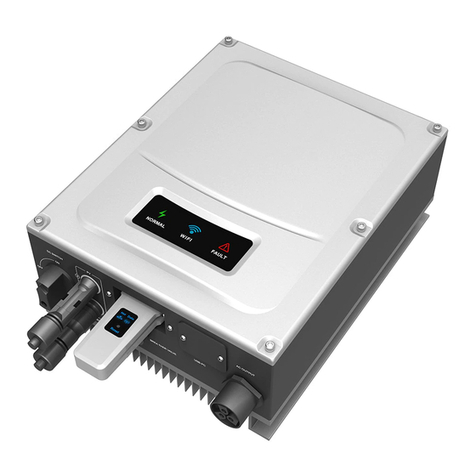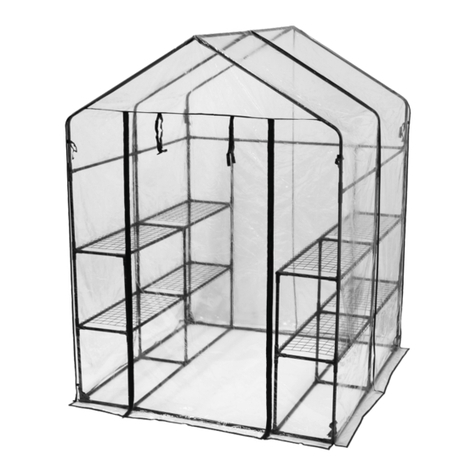
3
SECTION
No TITLE ASSEMBLY SYNOPSIS: IMPORTANT INFORMATION / CONSIDERATIONS
PARTS LIST Identify and separate all like for like components prior to assembly. The ‘parts list’ also separates parts into the various sec-
tions 1 - 12 shown below. Parts can also be identified by their profile pictures and stated lengths etc..Tools required.
B
BASE Base dimensions and recommendations. Ensure that your base is level as this will make assembly of the building, especially
the glazing of the roof much more straight forward. Please be aware that the hinge door on your greenhouse opens inwards,
make sure that there will be no interference between the door and the foundations.
P PREPARATION IMPORTANT:
Use WD40 or similar in the glazing bar channels and insert the black glazing rubber prior to frame assembly.
1 PORCH GABLE
Ensure that the gable framework is rubbered-up. Follow the diagrams to assemble the porch gable. Make sure that you have
inserted the extra bolts utilised in section 4.
2 LEFT (2L) AND
RIGHT (2R)
END GABLES
Again ensuring that the gable framework is rubbered-up follow the diagrams to assemble each gable in the building. Make
sure that you have inserted the extra bolts utilised in sections 4 and 5. On the roof and side corner bars not every rubber
channel will require rubber unless it is to be utilised in a partition (see separate manual and section P).
3 PORCH
RETURNS The porch returns (the L-shaped area to the left and right of the porch gable between cills and gutters level) can either be
built in situ piece by piece or built away from the structure as an L-shape and then attached in a similar manner to the end
and porch gables. Please ensure that where relevant you slide 2 x 22mm bolts into the side bars for the attachment of the
DV100 eaves spandrels.
4
5
JOINING THE
SIDES AND
VALLEY
GUTTER
Take the porch gable (1) and end gables (2L & 2R) and join them together on your wall. It is a good idea to tie some ladders
to the gables to support them if you do not have anyone to hold them for you. Check that the D234 foam is still attached to
your wall bars ‘DV471’ (also detailed on page 17). On models longer than 8’ e.g. 16’ an extension (4’ or 8’) is needed either
side of the 8’ core (16’ = 4’ext + 8’core + 4’ext) to make the desired length.
6a REAR ROOF Attach the main ridge between the end gables and then the rubbered-up roof bars ‘DV253’ ensuring that they are fully butted
up to the ridge and down onto the gutter. Attach your cresting before you glaze the building to give yourself more room to
work. Utilise the 22mm bolts slid into the roof bars to attach your DV100 and DV101 spandrels. On longer models you may
need to carefully prop up the roof and tie the sides together to keep the ridge and gutters straight (i.e. not sagging or bowed)
until the building is fully glazed.
6b PORCH ROOF The porch ridge can be fitted to the porch gable supporting its free end with ladders or a wooden sprag. The porch hips
‘DV381’ can now be attached between the welded porch gutter sections and the free end of the porch ridge. A ‘lower’ height
porch utilises a DV380 bracket to allow the porch ridge to connect to the main module. Identify all of the handed roof bars and
look for their locations. Insert the rubber into their channels and when attaching ensure again that were relevant you slide in
22mm bolts for eave (x2) and roof spandrels (x2). Eave and Roof sprandrels can now be attached using the previously in-
serted 22mm bolts. The ladders / sprag supporting the porch ridge free end can now be removed.
Prior to glazing the cresting and finials should be siliconed into place. Attaching them once the glass has been installed by
leaning through vent apertures is more time consuming.
7 VENT
VENT SLAM
Once the vent is glazed add silicone to the vent sides and top. Stand the vent/s on their hinge (vent top) and then leave the
silicone to set. The slam bar ‘D079’ can be moved up and down between the roof glazing bars so that it can be butted down
onto the pane of glass beneath, the autovent will be attached to it later on (10).
8
LOUVRE They attach to the building during the glazing process (9) like a piece of glass with a black separator above them. If you are
fitting an optional auto-louvre then you need to carefully drill (3mm bit) out the rivets which mount the handle to the frame.
You can then either utilise those holes or create more to mount the unit.
9 GLAZING Layout the bar cappings and covers around the building like a sundial checking that all is present and correct. You can also
place the roof cappings in the gutters so they are closer to hand. Use the capping and the self tapping screws to then hold the
glass in place. The covers then enclose the screw heads giving a neat finish. It is a good idea to glaze two roof sections first
to ensure the building is square followed by two side sections to ensure the building isn't leaning. We would then recommend
that you glaze the porch roof and its adjoining angled roof panes whilst the building still has some movement in it.
The porch cowling ‘DV341’ should be attached before the vents are inserted so that access through vent apertures is avail-
able. Silicone the cowling area internally, position cowl and VERY carefully (avoiding glass below) mark, drill and screw x 2
‘FS6018’ into place. IMPORTANT: Silicone the cowling externally and check with watering can that the cowl is water tight,
note silicone can be moulded shortly after application if you wet your fingers.
IMPORTANT: On the roof sections please make sure that you place a screw around 25mm / 1” from the bottom of each cap-
ping strip (create a hole in the plastic if required) and that the screws are nice and tight to avoid any glass slippage.
10 VENT
ATTACHMENT Take the assembled vent and slide the vent hinge ‘D866’ into the end of the ridge allowing the vent to pivot open and closed.
Vent stops go either side of the vent to stop any lateral movement (so insert stop / vent / stop). Attach the Bayliss XL aut-
ovents.
11 DOOR
ATTACHMENT Your door comes pre-constructed and locked minus the handles and their pivot pin but now it needs to be mounted to the
front end of your building. Utilise the ‘D522’ plates and twist in crop headed bolts to join the door and its frame to the building
(pinch the door frame against your long front verticals whilst tightening your ‘D522’ plates to ensure that there is no gap). If
you are struggling to eradicate the gap between the door frame and verticals then some silicone can be carefully applied to
the area to create a vertical seal. Be careful not to lock yourself in the building and to avoid damage do not open the door
until it is attached to the front gable. Getting the door to swing perfectly without dropping or rubbing on the ground may re-
quire some small but vital adjustments. You may also need to insert a packer underneath the door frame hinge to increase
ground clearance. Part ‘DV275’ canopies the door frame top hiding the clearance space at the top of the door. The door can
only be made to swing inwards.
IMPORTANT: Please do NOT let the door slam open or closed as it is likely to cause damage to the door and the frame.
Please twist the handle to open and close. Please also be aware that your door KEYS (3 provided) are unique to the building
so they should not be stored together.
12 ANCHORING
DOWN Now that the greenhouse is finished and the door and vent/s are operating without interference then you need to anchor the
building down using 2” rawl plugs and screws. Use a 7mm masonry bit in a hammer drill to create the holes.
13 FINISHING
TOUCHES Now that the main body of the structure is complete you can add; downpipe fittings, eave bungs, gutter stop ends. It is also
important to carefully apply some silicone to the internal eaves corners and external and internal ridge corners to minimise
the chance of water entering the structure.
14 OPTIONAL
SHELVING
Robinsons integral cantilever staging and shelving attaches to the inside of the greenhouse frame using either square head
bolts (insert four into each glazing barduring construction or rectangular ‘crop head’ bolts which can be fitted retrospectively
(both sets of bolts accompany the shelving/staging). This system allows the height of either the staging or the shelf to be set
at an operator specific height. Commonly the staging brackets are set 900mm from the floor though you can alter this to suit
the end user/s. The aluminium shelf / staging slats come in two lengths; (4’):1240mm ‘D2002’ and (6’):1860mm ’D2003’.
These slats can combine to create any length of staging required, i.e. 4’+6’ = 10’ etc...
15 OPTIONAL
STAGING
